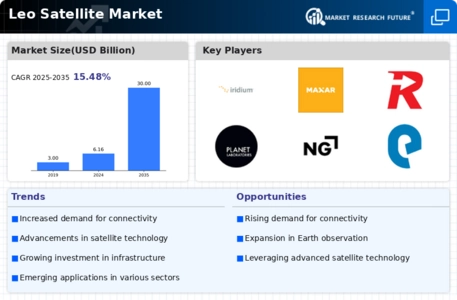Government Initiatives and Funding
Government initiatives play a pivotal role in the Leo Satellite Market, as various nations recognize the strategic importance of satellite technology. Many governments are allocating substantial funding to support the development and deployment of satellite constellations. For instance, recent reports indicate that investments in satellite technology could exceed 20 billion dollars over the next five years. These initiatives aim to enhance national security, improve communication infrastructure, and foster technological innovation. As a result, the Leo Satellite Market is likely to benefit from increased collaboration between public and private sectors, leading to accelerated advancements in satellite capabilities.
Growing Demand for High-Speed Internet
The Leo Satellite Market is experiencing a surge in demand for high-speed internet services, particularly in underserved regions. As more individuals and businesses seek reliable connectivity, the deployment of low Earth orbit satellites becomes increasingly attractive. According to recent data, the number of satellite internet subscribers is projected to reach 10 million by 2026, indicating a robust growth trajectory. This demand is driven by the need for enhanced digital services, including remote work, online education, and telehealth. Consequently, companies in the Leo Satellite Market are investing heavily in satellite technology to meet this growing need, which is likely to reshape the telecommunications landscape.
Increased Investment from Private Sector
The Leo Satellite Market is attracting significant investment from the private sector, as venture capitalists and technology firms recognize the potential for lucrative returns. Recent data indicates that private investments in satellite technology have surged, with funding reaching approximately 15 billion dollars in the past year alone. This influx of capital is facilitating the development of innovative satellite solutions and expanding the range of services offered. As private companies continue to enter the Leo Satellite Market, competition is likely to intensify, driving further advancements and potentially lowering costs for consumers.
Rising Demand for Earth Observation Services
The Leo Satellite Market is experiencing a notable increase in demand for earth observation services, driven by various sectors such as agriculture, environmental monitoring, and disaster management. The ability to collect high-resolution imagery and data from low Earth orbit satellites is becoming increasingly valuable for decision-makers. Recent estimates suggest that the earth observation market could grow to 5 billion dollars by 2027, highlighting the potential for Leo satellites to play a crucial role in this sector. As industries seek to leverage satellite data for improved insights, the Leo Satellite Market is likely to expand, offering new opportunities for service providers.
Technological Advancements in Satellite Design
The Leo Satellite Market is witnessing rapid technological advancements in satellite design and manufacturing. Innovations such as miniaturization, improved propulsion systems, and enhanced communication payloads are enabling the deployment of more efficient satellite constellations. Recent studies suggest that advancements in satellite technology could reduce launch costs by up to 30 percent, making it economically viable for more companies to enter the market. This trend not only fosters competition but also enhances the overall capabilities of satellite networks. As technology continues to evolve, the Leo Satellite Market is poised for transformative growth, potentially leading to new applications and services.




















